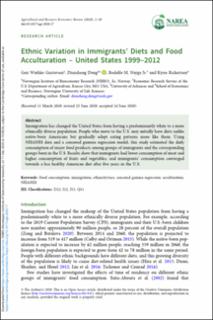| dc.contributor.author | Gustavsen, Geir Wæhler | |
| dc.contributor.author | Dong, Diansheng | |
| dc.contributor.author | Nayga, Rodolfo M. Jr. | |
| dc.contributor.author | Rickertsen, Kyrre | |
| dc.date.accessioned | 2020-12-16T15:43:15Z | |
| dc.date.available | 2020-12-16T15:43:15Z | |
| dc.date.created | 2020-08-03T11:42:10Z | |
| dc.date.issued | 2020 | |
| dc.identifier.citation | Agricultural and Resource Economics Review (ARER). 2020, 1-20. | |
| dc.identifier.issn | 1068-2805 | |
| dc.identifier.uri | https://hdl.handle.net/11250/2719916 | |
| dc.description.abstract | Immigration has changed the United States from having a predominantly white to a more ethnically diverse population. People who move to the U.S. may initially have diets unlike native-born Americans but gradually adopt eating patterns more like them. Using NHANES data and a censored gamma regression model, this study estimated the daily consumption of major food products among groups of immigrants and the corresponding groups born in the U.S. Results show that immigrants had lower consumption of meat and higher consumption of fruits and vegetables, and immigrants’ consumption converged towards a less healthy American diet after five years in the U.S. | |
| dc.language.iso | eng | |
| dc.title | Ethnic Variation in Immigrants’ Diets and Food Acculturation – United States 1999–2012 | |
| dc.type | Peer reviewed | |
| dc.type | Journal article | |
| dc.description.version | publishedVersion | |
| dc.source.pagenumber | 1-20 | |
| dc.source.journal | Agricultural and Resource Economics Review (ARER) | |
| dc.identifier.doi | 10.1017/age.2020.17 | |
| dc.identifier.cristin | 1821281 | |
| dc.relation.project | Norges forskningsråd: 233800 | |
| cristin.ispublished | true | |
| cristin.fulltext | original | |
| cristin.qualitycode | 1 | |
